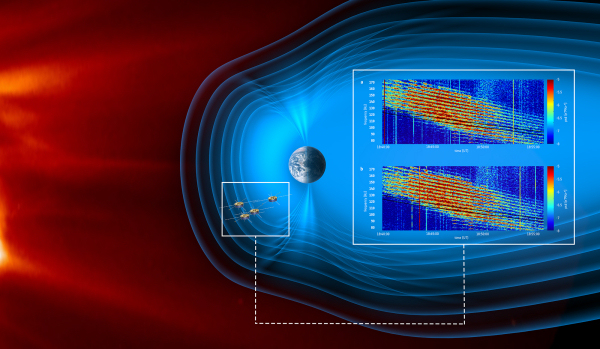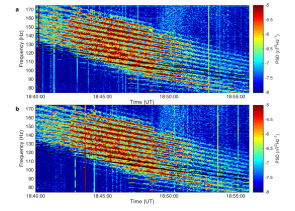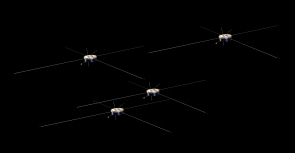Cluster solves the mystery of equatorial noise
14 July 2015
ESA's Cluster mission has solved a mystery which puzzled scientists for almost half a century. Data sent back by two of the spacecraft have revealed for the first time the physical mechanism behind the generation of "noisy" waves in near-Earth space.
 |
| Cluster observes the structure of equatorial noise. Credit: ESA/ATG medialab |
Back in 1966, a NASA satellite known as OGO-3 discovered 'noisy' plasma waves at an altitude of around 18 000 km above the Earth.[1] The waves occurred very close to the equatorial plane of the planet's magnetic field – the geomagnetic equator.
The location of the electric and magnetic fields of these waves, together with their unstructured nature, led to them being termed 'equatorial noise'. This 'noise' turned out to be one of the most frequently observed emissions in near-Earth space, being detected by many spacecraft as they fly over the geomagnetic equator.
Observations over the years by various space missions showed some evidence for discrete frequency bands, suggesting that the waves may interact with protons, alpha particles, and electrons near the geomagnetic equator. However, the width and spacing of these frequency bands appeared to be non-uniform and could not be accurately measured, except at low frequency.
Although several theories were proposed to explain how these waves were generated, their value was limited by a lack of clear observational evidence that could be used to support modelling of the phenomenon, and by the limited accuracy of the proposed models.
In an effort to solve the mystery of the generation and propagation of the equatorial noise, an international team of scientists decided to take advantage of the multipoint observations provided by ESA's Cluster mission. A specially planned Inner Magnetosphere Campaign was introduced, to study the structure of these waves in their source region.
The most significant observations were made between 18:40 and 18:55 GMT on 6 July 2013, when all four Cluster spacecraft were flying through the outer radiation belt, close to the geomagnetic equator. Clusters 3 and 4 were very near - within 60 km of each other - while Cluster 1 was approximately 800 km from the pair, and Cluster 2 was around 4400 km away in the earthward direction from the other three.
 |
|
Observations of equatorial noise by STAFF instruments on Cluster 3 and Cluster 4. Credit: Balikhin and Shprits, et al. (2015). |
Observations by the Spatio-Temporal Analysis of Field Fluctuations (STAFF) instruments on Clusters 3 and 4 revealed that the waves had a highly structured and periodic pattern, providing clear observational evidence about how they were generated. The data also revealed in detail their banded structure, the most remarkable example of these structures ever observed in space.
The spectral lines showed multiples of the frequencies of the circular motion of protons in the presence of a uniform magnetic field – the so-called proton gyrofrequency. The observations of the 'noise' emissions were, in this case, much more coherent and structured than the majority of plasma waves.
"The clear appearance of the regular spectral lines associated with the waves reminded me of a comb," says Professor Michael Balikhin from the University of Sheffield, UK, a scientific principal investigator on Cluster and joint lead author of the paper in the journal Nature Communications which describes the research.
"They were found in the precise frequency range in which equatorial noise is usually observed. This previously unobserved, well organised, and periodic structure provided definitive evidence that the waves were generated by protons."
"It's truly remarkable how nature managed to draw such clear, narrow, and periodic lines in space," adds Yuri Shprits of UCLA, currently a Visiting Associate Professor at MIT, who led the study together with Michael Balikhin.
The Cluster measurements enabled not only the observation of the fine structure of the wave spectrum but also provided multi-satellite measurements of this emission at very short separation distances. The periodic pattern of emissions observed on Cluster 4 was almost an exact replication of that observed by Cluster 3, showing that the highly organised, periodic wave structure measured at least 60 km across.
The spectral observations, together with observations of particle distributions, allowed the researchers to calculate the growth rates of the waves. The Cluster spacecraft measurements also enabled them to determine the polarisation properties of the waves, further confirming that the observed emissions were the same type as those usually observed in equatorial noise waves.
This study clearly showed that these waves were produced by so-called ion ring distributions. This arrangement refers to the ring-like velocity distributions of the charged particles close to the geomagnetic equator, where more particles are observed at high velocity than low velocity. The Cluster spacecraft were able to measure these distributions, and models used by the scientists definitively showed that they are responsible for the excitation of the waves.
 |
| Artist's impression of the Cluster spacecraft. Credit: ESA/ATG medialab |
"This remarkable result would not have been possible without a mission such as Cluster," says Michael Balikhin. "The multipoint observations enabled us to study the wave structure over distance and time.
"The extraordinary data from the Cluster Inner Magnetosphere Campaign would have been impossible to obtain without the combined effort of the whole Cluster team."
"Studies such as ours help scientists to understand the processes that are taking place in near-Earth space," says Yuri Shprits. "By combining observations of waves, observations of the particles that produce these waves and physics-based modelling, we are able to improve our understanding of the dynamics of Earth's radiation environment. This may eventually help predict the dynamics of the space environment, which is hazardous to satellites."
"Waves in the inner magnetosphere have recently attracted much attention because they are capable of accelerating electrons to relativistic energies in the radiation belts or providing a mechanism that results in the loss of these particles into the atmosphere – two fundamental aspects of space weather," says Philippe Escoubet, ESA's Cluster project scientist.
"This study has definitively identified the source of the equatorial noise that was discovered almost half a century ago. Understanding the mechanisms behind the generation of waves may be important for studies of laboratory plasmas and of plasmas elsewhere in the Universe."
Notes
[1] Plasma is often described as the fourth state of matter. It consists of electrically charged particles, mainly electrons and protons.
Background information
The results described in this article are reported in Observations of Discrete Harmonics Emerging From Equatorial Noise, by Michael A. Balikhin, Yuri Y. Shprits, Simon N. Walker, Lunjin Chen, Nicole Cornilleau-Wehrlin, Iannis Dandouras, Ondrej Santolik, Chris Carr, Keith H. Yearby, Benjamin Weiss, published in Nature Communications, 14 July 2015.
Acknowledgement: STAFF Principal Investigator P. Canu, LPP/Ecole Polytechnique/CNRS.
Cluster is a constellation of four spacecraft flying in formation around Earth. It is the first space mission able to study, in three dimensions, the natural physical processes occurring within and in the near vicinity of the Earth's magnetosphere. Launched in 2000, it is composed of four identical spacecraft orbiting the Earth in a pyramidal configuration, along a nominal elliptical polar orbit of 4 × 19.6 Earth radii (1 Earth radius = 6380 km). Cluster's payload consists of state-of-the-art plasma instrumentation to measure electric and magnetic fields over wide frequency ranges, and key physical parameters characterising electrons and ions from energies of near 0 eV to a few MeV. The science operations are coordinated by the Joint Science Operations Centre (JSOC) at the Rutherford Appleton Laboratory, United Kingdom, and implemented by ESA's European Space Operations Centre (ESOC), in Darmstadt, Germany.
Contact
Michael Balikhin
Department of Automatic Control and Systems Engineering
University of Sheffield, UK
Phone: +44 114 222 5628
Email: m.balikhin![]() sheffield.ac.uk
sheffield.ac.uk
Yuri Shprits
Visiting Associate Professor at MIT / Researcher at UCLA
Phone: +1 617 2531902
Email: yshprits![]() atmos.ucla.edu
atmos.ucla.edu
Philippe Escoubet
Cluster Project Scientist
Scientific Support Office
Directorate of Science & Robotic Exploration
ESA, The Netherlands
Phone: +31 71 565 3454
Email: Philippe.Escoubet![]() esa.int
esa.int



